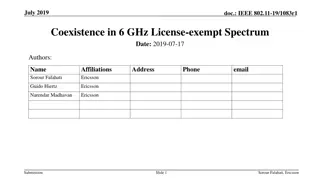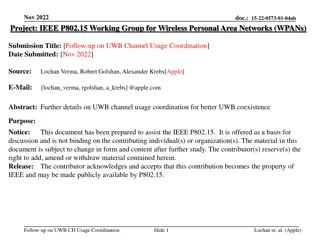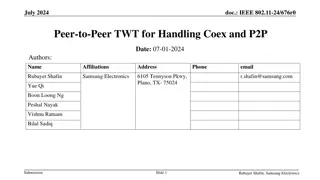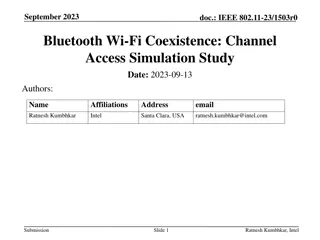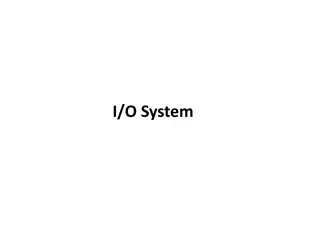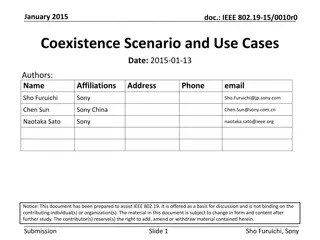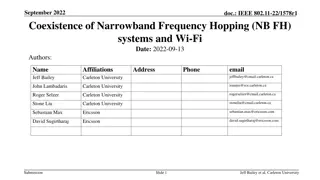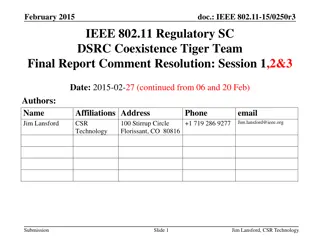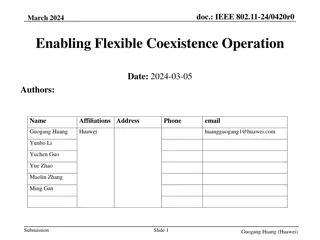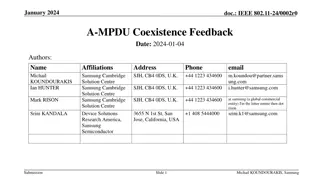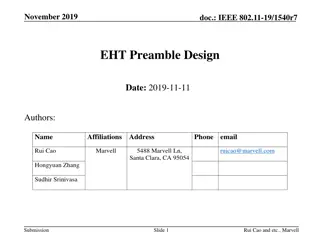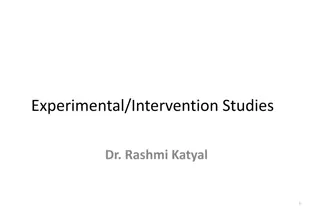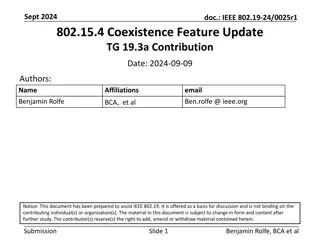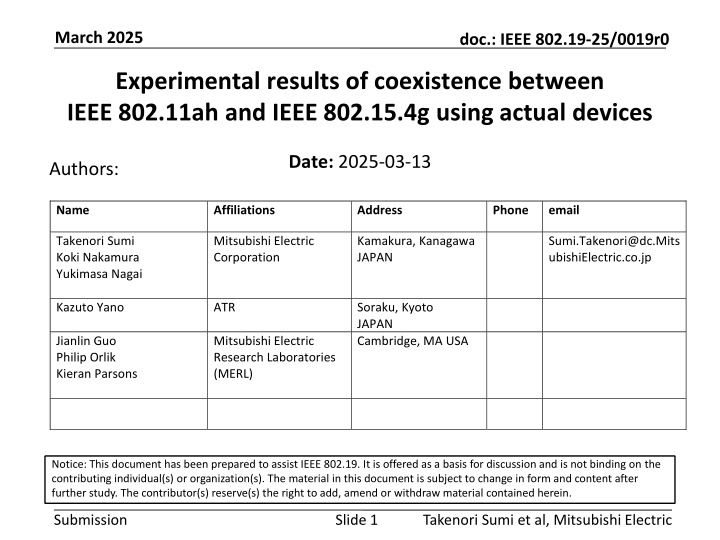
Experimental Results of IEEE 802.11ah and IEEE 802.15.4g Coexistence Evaluation
This document presents experimental results of coexistence evaluations between IEEE 802.11ah and IEEE 802.15.4g using actual devices. Conducted by Mitsubishi Electric, the experiments assess the impact of coexistence through examinations of IEEE 802.11ah uplink data rates, packet sizes, and more. Explore the preliminary evaluation findings and look forward to future experiments planned for the May meeting.
Download Presentation

Please find below an Image/Link to download the presentation.
The content on the website is provided AS IS for your information and personal use only. It may not be sold, licensed, or shared on other websites without obtaining consent from the author. If you encounter any issues during the download, it is possible that the publisher has removed the file from their server.
You are allowed to download the files provided on this website for personal or commercial use, subject to the condition that they are used lawfully. All files are the property of their respective owners.
The content on the website is provided AS IS for your information and personal use only. It may not be sold, licensed, or shared on other websites without obtaining consent from the author.
E N D
Presentation Transcript
March 2025 doc.: IEEE 802.19-25/0019r0 Experimental results of coexistence between IEEE 802.11ah and IEEE 802.15.4g using actual devices Date: 2025-03-13 Authors: Name Affiliations Address Phone email Takenori Sumi Koki Nakamura Yukimasa Nagai Kazuto Yano Mitsubishi Electric Corporation Kamakura, Kanagawa JAPAN Sumi.Takenori@dc.Mits ubishiElectric.co.jp ATR Soraku, Kyoto JAPAN Cambridge, MA USA Jianlin Guo Philip Orlik Kieran Parsons Mitsubishi Electric Research Laboratories (MERL) Notice: This document has been prepared to assist IEEE 802.19. It is offered as a basis for discussion and is not binding on the contributing individual(s) or organization(s). The material in this document is subject to change in form and content after further study. The contributor(s) reserve(s) the right to add, amend or withdraw material contained herein. Submission Slide 1 Takenori Sumi et al, Mitsubishi Electric
March 2025 doc.: IEEE 802.19-25/0019r0 Introduction We have conducted coexistence evaluations of IEEE 802.11ah and IEEE 802.15.4g through computer simulations. In this document, we report the results of evaluating the impact of coexistence through experiments using actual IEEE 802.11ah and IEEE 802.15.4g devices. This time, we are presenting the preliminary evaluation results. We are planning additional experiments for the May meeting. If you have any comments on the measurement items or conditions that should be obtained, please let us know. Submission Slide 2 Takenori Sumi et al, Mitsubishi Electric
March 2025 doc.: IEEE 802.19-25/0019r0 Measurement Equipment IEEE 802.11ah IEEE 802.15.4g AP : Silex AP-100AH(JP) STA: Silex BR-100AH(JP) Silicon Labs EFR32FG25 https://www.silabs.com/wireless/proprietary/efr32fg25-sub-ghz-wireless-socs https://www.silex.jp/products/accesspoint/list/ap100ah https://www.silex.jp/products/bridge/list/br100ah Submission Slide 3 Takenori Sumi et al, Mitsubishi Electric
March 2025 doc.: IEEE 802.19-25/0019r0 Measurement Environment 802.15.4g Node#2 802.15.4g Node#1 802.11ah STA#2 802.15.4g PANC 802.11ah STA#1 802.11ah AP Uplink traffic Uplink traffic is transmitted from both IEEE 802.11ah STAs and IEEE 802.15.4g nodes. Submission Slide 4 Takenori Sumi et al, Mitsubishi Electric
March 2025 doc.: IEEE 802.19-25/0019r0 Evaluation Specifications 802.11ah uplink data rate/STA[kbps] 802.11ah packet size[Byte] 802.11ah MCS 10 60 100 0 (333 kbps), 3 (1333 kbps), 7 (3333kbps) 1 1.6 100 Option3 MCS 4 (300 kbps), Option3 MCS 5 (400 kbps) 400 802.11ah bandwidth[MHz] 802.15.4g uplink data rate/node[kbps] 802.15.4g packet size[Byte] 802.15.4g MCS 802.15.4g bandwidth[kHz] Both IEEE 802.11ah and IEEE 802.15.4g perform transmissions to maintain a duty cycle of less than 10%. Submission Slide 5 Takenori Sumi et al, Mitsubishi Electric
March 2025 doc.: IEEE 802.19-25/0019r0 Evaluation Results IEEE 802.11ah Jitter IEEE 802.15.4g Frame Error Rate * If the IEEE 802.11ah device is not activated, the frame error rate is 0. 1 100 15.4g MCS4 15.4g MCS5 15.4g MCS4 15.4g MCS5 0.9 90 0.8 80 15.4g Frame Error Rate 11ah MCS0 0.7 70 11ah Jitter[ms] 0.6 60 0.5 50 0.4 40 11ah MCS3 11ah MCS3 11ah MCS0 0.3 30 0.2 20 11ah MCS7 1000 11ah MCS7 0.1 10 0 500 1500 2000 2500 3000 3500 0 500 1000 1500 2000 2500 3000 3500 0 0 0 500 1000 1500 2000 2500 3000 3500 0 1000 2000 3000 4000 11ah PHY Rate[kbps] 11ah PHY Rate[kbps] As the PHY rate of IEEE 802.15.4g increases, the jitter of IEEE 802.11ah decreases. On the other hand, the frame error rate of IEEE 802.15.4g remains unchanged even if the PHY rate of IEEE 802.15.4g increases. Additionally, since there are cases where the frame error rate increases with MCS 3 compared to MCS 0 in IEEE 802.11ah, an increase in the PHY rate of IEEE 802.11ah does not necessarily result in a decrease in the frame error rate of IEEE 802.15.4g. Submission Slide 6 Takenori Sumi et al, Mitsubishi Electric
March 2025 doc.: IEEE 802.19-25/0019r0 Summary This contribution presents the results of a preliminary evaluation of coexistence between IEEE 802.11ah and IEEE 802.15.4g using actual devices. o When IEEE 802.11ah and IEEE 802.15.4g coexist, the jitter of IEEE 802.11ah can increase to around 70 ms, and the frame error rate of IEEE 802.15.4g can increase to around 30 %. We are presenting the preliminary evaluation results. We are planning additional experiments for the May meeting. If you have any comments on the measurement items or conditions that should be obtained, please let us know. Submission Slide 7 Takenori Sumi et al, Mitsubishi Electric





